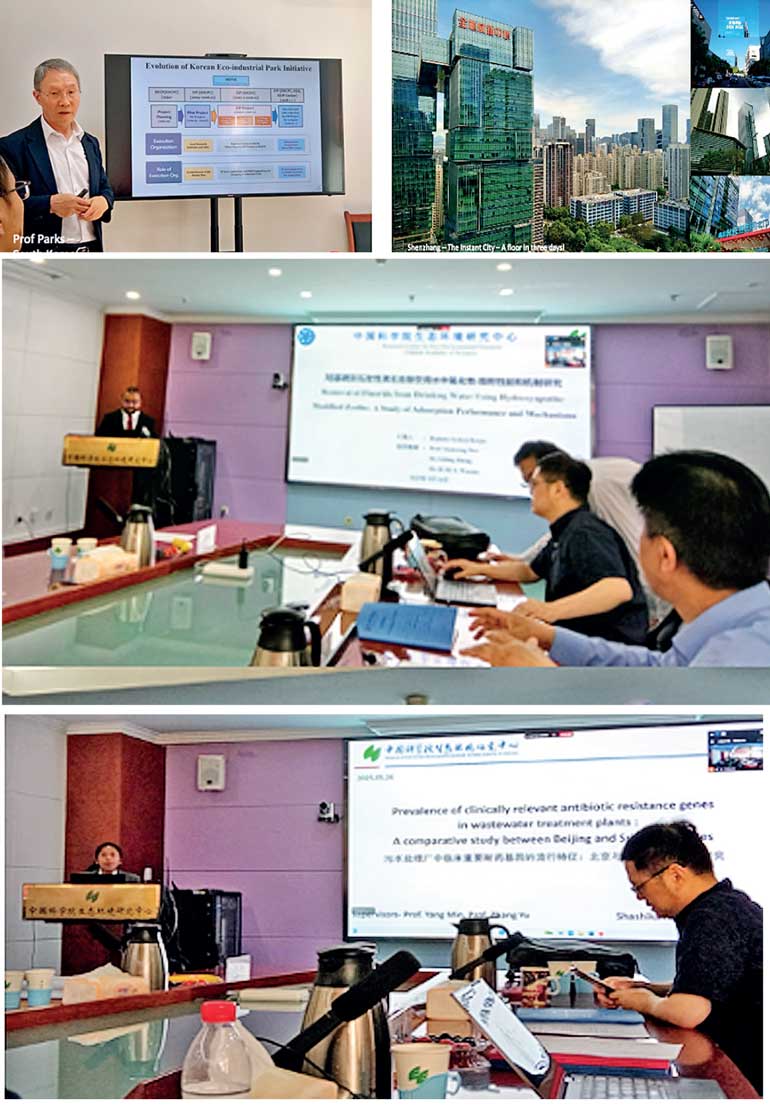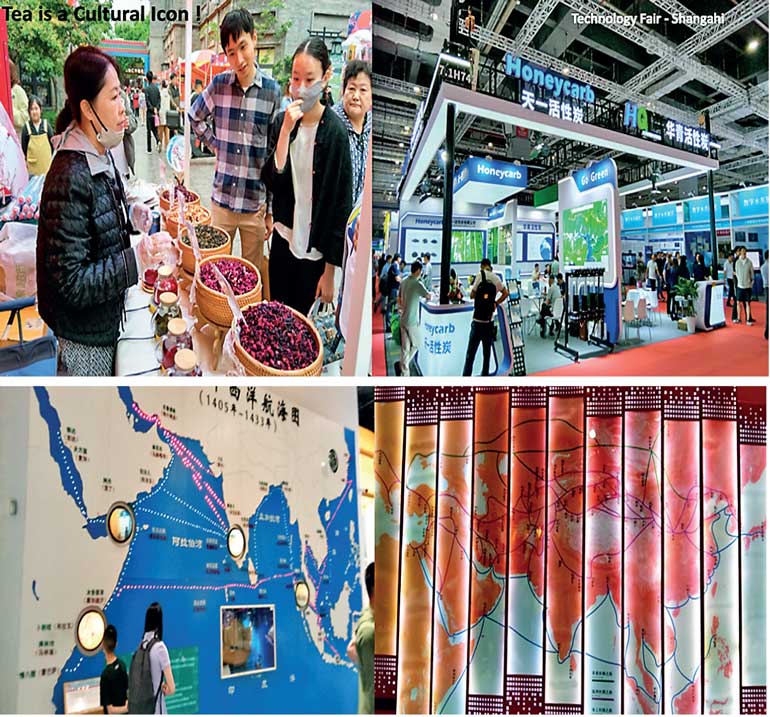Friday Dec 05, 2025
Friday Dec 05, 2025
Friday, 18 July 2025 00:20 - - {{hitsCtrl.values.hits}}


 I was born in 1961, which happened to be in Sri Lanka. Suppose my birth happened in China in that year. In that case, it is quite unlikely that my trajectory would have been to be a vegetarian. In 1961, China was suffering from one of the worst famines a country has ever suffered – three years of great famine. In such an environment, you do not have the luxury of exercising choices. As I leave after a three-month stay, I have experienced a China that to me is seen as plentiful, productive, powerful, and purposeful.
I was born in 1961, which happened to be in Sri Lanka. Suppose my birth happened in China in that year. In that case, it is quite unlikely that my trajectory would have been to be a vegetarian. In 1961, China was suffering from one of the worst famines a country has ever suffered – three years of great famine. In such an environment, you do not have the luxury of exercising choices. As I leave after a three-month stay, I have experienced a China that to me is seen as plentiful, productive, powerful, and purposeful.
I had the opportunity to travel widely and meet researchers, academicians, and industrialists. Of course, my interest was in science and technology, and my singular observation is how connected the growth of China has been to its reliance on science, technology, and education. Of course, the acceleration of China happened after the opening up of its economy was done in the China way. Believe, however, the mindset of people and the work ethos, irrespective of open or closed system, played a dominant role in shaping China to be what it is today.
Sticking to the knitting
The decision-making, as well as sticking to the knitting, perhaps, is the secret of China’s success. I had the opportunity to present on industrial estate developments in China in the presence of a pioneer in this area from Korea (Prof. Parks) at CARES. Tracing the history, I pointed out that Sri Lanka had the first industrial estate in the region way back in 1957 (actually two estates, one at Ekala Jaela and the other at Ratmalana), and this effort was way ahead of both China and Korea. We had a near-perfect institutional setting with research centres, venture fund system (DFCC Bank), and a State Industrial Estate Development Corporation. Well, we know how they have progressed, while both China and Korea, very much late comers now, owe a significant percentage of their GDP to the contribution from industrial estates.
Another interesting thought crossed my mind when I was in Shenzhen. This is the place where China first experimented with the open economy transformation, and they declared this area a Special Economic Zone. They were seeing Hong Kong and its differences on the other side of the Pearle River. China started the transformation of Shenzhen in 1980, and it was at the same time as Katunayake was developed as a Free Trade Zone. China opted to use the Special Economic Zone, as I indicated earlier, as they opened up with their own way.
Determination to stay on course
I asked you to think of Katunayake and Shenzhen today. China also shifted its planned economy to a market economy starting at the end of 1978. Situations developed as per the vision, applied mindset, and of course, with the determination to stay on course. I indicated in my last column the integration of education to development and the central position given to science and technology. Science and Technology talent is giving the real edge to China on the global stage, and it is all from education.
It matters a lot what you set out to achieve. An interesting comparison can be made here as well. Sri Lanka never connected education to industry. Education was free and was considered a right! The purpose of education was never factored in for the economy. Science and Technology, one can say was almost absent and that continues to date. Research institutes and research leaders had game-changing challenges placed in front of them. A listing of developments asked for and delivered were two missiles and one satellite, high tech projects, domestic large aircraft, integrated circuits, manned space program, lunar exploration program, new energy vehicles and high-speed rail transportation, etc. A list that I have seen in a Sri Lankan research institute from the same period indicates important projects to be carried out as improvement to the bullock cart, improved cookstove, etc. Hope you see the difference in goals.
Mineral exploration in China did not stop at extraction and sale. Technology was developed to ensure significant value addition. This positioned some of the unique resources available in a globally competitive manner. The efforts of such endeavours are clear today, with China flexing its muscle with rare earths in international trade.
Science and technology
In Sri Lanka today, one sees and hears continuously the issue of loss-making SOEs. When you see some of those SOEs, they have interesting asset bases of high value. It is simply inconceivable to think why they should be making such losses. Definitely, the dissociation of the enterprise from science and technology is the reason for the poor situation. I see, however, no discussion is ever taking this as the issue for the current predicament, other than stating transfer of ownership, sale of assets, etc., given as the way out of the financial mess.
An interesting lesson to be had from China is how research institutes underwent reforms. The objectives and deliverables did not change as they were tied to the developments the centre was asking for. Reforms in 248 institutions, 89 to be managed as non-profit research institutes under state support, 61 shifted into enterprises, and the rest were incorporated into universities or other public institutions. Once planned, they ensured reforms in a quick time. A key aspect was the understanding of the meaning of an enterprise and market becoming the key factor in providing the growth orientation and scale of Science and Technology.
It is possible to observe research institutes aligned with industry sectors. The Chinese Academy of Sciences (CAS) has institutionalised a CASH system to manage spinouts and startups coming from in-house research. CASH of CAS is a lesson that I have taken. A comment to be made here is that when there is a dominant manufacturing industry in an economy, that sector always has behind it a strong research and development institution.
It was while in Beijing that the US ‘liberation day’ events unfolded, and the learnings were really thus from the frontline. COVID had shown the option of China+1 to those looking to receive manufactured goods from China. The first Trump presidency has shown that tariff is a possible policy mechanism against China, thus the emerging scenario was not new. As there were many other countries considered simultaneously in the present tariff conflict there were chances for different alliances in addressing the present challenge. One learning is how difficult it is to start and scale manufacturing and the skill bases necessary to ensure sustenance.
Monetisation
One aspect that stuck me was that even if you are happy with design protection and royalties, a sale of the manufactured good to realise such rights. Monetisation is intrinsically connected to manufacturing and demand fulfilment. As the tariffs were on goods and not on services, it was manufacturing that came into focus. A visit to an environmental technology trade fair in Shanghai, the numbers were bewildering – 4000+ technology firms were in attendance eagerly searching for trade and deployment. Even the smallest production facility appears to have a connection to a university or a research facility.
Knowledge is considered a significant asset, and that was a critical observation that I had. At the entrance, it was interesting to observe an Intellectual Property dispute resolution counter set up by the event organisers themselves to quickly handle IP disputes if any. The Belt & Road Initiative of China is essentially a diversification strategy for trade and exchange. As per Sri Lanka, the modern Belt & Road is not exactly the old Silk Road, as the earlier northern connectivity has been shifted to the south in defining the Belt for Sri Lanka.
The economic journey of China, based on science, technology, and education, and with a market economy mindset, has been impressive. In 2009, China surpassed Japan’s GDP to become the second-largest economy. In 2010, China overtook Germany in export volume & became the world’s largest exporter. In 2013, the US the total volume of import and export trade and became the world’s largest trading country. At the beginning, China focused on a heavy industry strategy, whereas Sri Lanka too had a list of 10 heavy industries to initiate and develop.
Now, with a timeline similar to or even behind Sri Lanka, the path taken has yielded impressive results for China, and those lessons should not be lost on us. Specifically, when we can match ourselves with China, the analysis is not difficult. It is clear that Sri Lanka did focus on Education and yielded excellent returns, as seen when the status of Millennium Development Goals was taken, but that education was not connected with Science and Technology, an important difference with China.
I left China after spending three months there and with so many lessons and friendships. The opportunity was 63 years after that infamous famine. What a journey China has taken, and around the day that I was leaving, I was listening to a test run of a train that has clocked 600km/hr. China was where tea as a drink was invented, and tea has strong cultural significance. Tea flows freely in any meeting, and the clicking of cups a moment of deep connection, and I had many. Will I be able to impart some of these lessons to our industry and decision makers? My parting thoughts as I left Beijing Capital.